Arcer Army: Difference between revisions
mNo edit summary Tag: 2017 source edit |
mNo edit summary Tag: 2017 source edit |
||
| (One intermediate revision by the same user not shown) | |||
| Line 25: | Line 25: | ||
| equipment = | | equipment = | ||
| equipment_label = | | equipment_label = | ||
| battles = | | battles = [[Arcer Bush Wars]], [[First Great War]], [[Ardmori Civil War]], [[Second Great War]], [[Istrenyan Crisis]], [[Telekonese Conflict]], [[Final War of the Deluge]] | ||
| decorations = | | decorations = | ||
| battle_honours = | | battle_honours = | ||
| Line 48: | Line 48: | ||
| identification_symbol = [[File:Arcer Army Logo-removebg-preview.png|border|100px]] | | identification_symbol = [[File:Arcer Army Logo-removebg-preview.png|border|100px]] | ||
}} | }} | ||
The Army of Arcerion is the largest branch in terms of personnel and mission set, however it is not the oldest branch of the Armed Services, with the senior branch being the Arcer Navy, which itself draws its lineage from the Arcer Maritime Patrol Service during the days where Arcerion was a Carnish colony. The Army itself is broken down into Active and Reserve components, with roughly 25-40% of troops belonging to Active, full-time Regiments, and the remaining being Reservists serving part-time. | The Army of Arcerion is the largest branch in terms of personnel and mission set, however it is not the oldest branch of the [[Armed Forces of Arcerion|Armed Services]], with the senior branch being the Arcer Navy, which itself draws its lineage from the Arcer Maritime Patrol Service during the days where Arcerion was a Carnish colony. The Army itself is broken down into Active and Reserve components, with roughly 25-40% of troops belonging to Active, full-time Regiments, and the remaining being Reservists serving part-time. | ||
=== History === | === History === | ||
==== Formation ==== | ==== Formation ==== | ||
Latest revision as of 13:56, 1 May 2023
This article is a work-in-progress because it is incomplete and pending further input from an author. Note: The contents of this article are not considered canonical and may be inaccurate. Please comment on this article's talk page to share your input, comments and questions. |
| Arcerion Army | |
|---|---|
| Arcer Army, Army, Land Forces | |
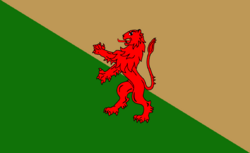 Camp Flag of the Arcer Army | |
| Founded | 4 September 1793 |
| Country | |
| Branch | Land |
| Type | Army |
| Role | Expeditionary Operations |
| Size | As of 2025, ~880k total personnel. |
| Motto(s) | "Forward." |
| Colours | Green, White, Black. |
| March | Kurst Grenadiers, at the Advance. |
| Anniversaries | 27 August (Founding), 11 December (Battle of the Winter Wood) |
| Engagements | Arcer Bush Wars, First Great War, Ardmori Civil War, Second Great War, Istrenyan Crisis, Telekonese Conflict, Final War of the Deluge |
| Website | arcerionarmy.mil.arc |
| Commanders | |
| Commander, Army General Staff | General Kenneth Saunders |
| Chief of Staff | LGen Johnathan Quick |
| Insignia | |
| Identification symbol | 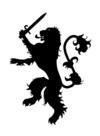 |
The Army of Arcerion is the largest branch in terms of personnel and mission set, however it is not the oldest branch of the Armed Services, with the senior branch being the Arcer Navy, which itself draws its lineage from the Arcer Maritime Patrol Service during the days where Arcerion was a Carnish colony. The Army itself is broken down into Active and Reserve components, with roughly 25-40% of troops belonging to Active, full-time Regiments, and the remaining being Reservists serving part-time.
History
Formation
The Arceiron Army was initially formed as local militia and garrison units to support regular Carna soldiers stationed in the colony during Royal rule. However, as Carna itself evolved, and Arcerion gained more independence, these soldiering formations took on more and more of the governance, security, and border patrolling duties from their colonial masters, who instead withdrew to the cities, leaving the wild plains of Arcerion to be patrolled by soldiers born and raised there. The first regiment, the Arcerion Loyal Militia, was formed in 1793, and it is from this unit that the Army draws its lineage. Many of its Regiments have named their individual rifle companies after the Militia's own, for example in the 1st Battalion, Kurst Foot Grenadiers, the 'A' Company, or first of the battalion, is known as "Loyal," Company, an homage to the Militia.
the Militia would serve with distinction throughout the many border skirmishes and internal conflicts in Arcerion during the formative years, resulting in lessened Carnish presence in Arcerion, and by the 1850s, only a few token companies of Carnish soldiers remained in the capital to maintain a foothold, whilst Arcerion was able to police and secure its own borders successfully up to this point.
Early History
Great War and Early Modern Period
Modern Period
Regalia, Regimental Colours, and Battle Honours
Regimental Standards and Colours, often referred to as 'the Colours' are a significant part of the Army's heritage. Due to not having the designation 'Royal,' only individual units of the Arcer Army can be designated as Royal. As such, Regimental Colours are cloth or heavy fabric and silk, adorned with battle honours assigned to them by Royal Decree. However with the abolition of the Carnish Crown during the Carnish Revolution, many Regiments receive modern Battle Honours by an Act of Parliament.
Current Deployments
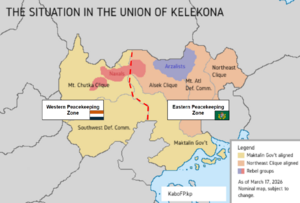
The Arcer Army currently has several commitments, both as national missions and as part of the greater Cronan Security and Trade Union commitment for peace and security in Crona. Arcerion maintains a peacekeeping presence in Kelekona as part of Operation Redoubt, which regularly sees a considerable number of infantry and armoured battalions cycling through, with support from other arms to build infrastructure and mentor host nation forces. Additionally, members of the Arcerion Commando Regiment regularly conduct counter-terror special operations missions in Kelekona, Telokona, and Malentina, although the Arcer government has yet to officially announce their deployment outside of the Northwest Border Security Zone (NWBSZ). The NWBSZ is a deomestic support to civil authority missions that annually sees three battalions rotated into Oakham governorate to support the civilian administration due to the high influx of illegal immigrants and refugees fleeing Varshan following the Final Deluge .
Arcerion also provides soldiers annually for peacekeeping operations in the former Varshan, as well as a special operations presence to aide the League of Nations in finding, detaining, and/or arresting members of the Varshani government-in-exile that perpetrated war crimes or crimes against humanity during the 2020s conflict.
Organization and Doctrine
The Arcer Army is centered around its brigade groups, which as per the 2022 Confederate Memo on Defence, are focused around infantry battalions with supporting ISR and fires assets, while maintaining their integral engineer and light armour support. Where the Army lacks is in heavy, direct-fire support, being a legacy colonial military, the emphasis on excellent light infantry and skirmishers, complemented by its garrison artillery and mobile cavalry reinforcements. The transition to today has seen this result in superb light infantry battalions, with an emphasis on motorisation and the ability to cover open country, such as the Governate of Northlea, quickly. The garrison and coastal artillery units have meant that the modern Regiment of Arcer Horse Artillery (RAHA) has an exceptional understanding of modern fires planning, as well as the usage of ISR for targeting. The cavalry gradually evolved into two branches within the Arcerion Armoured Corps, the Cavalry branch and the Armoured Reconnaisance Branch; the former being tanks and direct-fire support vehicles, and the latter focused on ISTAR. The Army has several types of Brigades, all centered around some form of infantry or combat arms unit.

The Arcer Army order of battle centers around the creation of combat teams, which themselves are a combined-arms effort of multiple Corps and Branches within the Army. The Combat Team is the main operational arm of the Arcer Army, and while not the lowest operationally-tasked unit (that being the company), it operates as a self-contained unit able to conduct offensive, defensive, and stability operations. The Combat Team is comprised of (1) infantry company with (1) platoon-sized element of supporting combat engineers, (1) forward observer vehicle from the Regiment of Arcer Horse Artillery, (1) squadron-equivalent formation of supporting armour or direct fire (ie. armoured reconnaissance or main battle tanks), as well as a rear echelon including medical staff, signalers, vehicle and maintenance technicians, and other enablers as required.
The convention for the Combat Team is that it is organized and commanded by a Major (OF-3), or a senior Captain (OF-2) in extremis with either operational experience or with the necessary qualifications. The 2IC, or 2nd in Command is a Captain. Individual formations and sub-units within a Combat Team are usually Lieutenants (OF-1). NCOs are present without, with several Warrant Officers (OR-8) and Colour/Staff Sergeants (OR-7), present to provide subject matter expert advice as well as guidance.
The Army above the combat team is organized into Battalions or Regiments, each commanded by a Light Colonel (OF-4). These Regiments and battalions are centered on a combat arms unit, and formed into the Arcer Army's fighting brigades, the most common being infantry. Brigades are each commanded by a Colonel or Brigadier (OF-5). These brigades are grouped into their own Divisions, of which Arcerion has 5, 3 full-time divisions dedicated to rotating through a high-readiness cycle, and the other two being Reserve formations responsible for the administering of professional development courses, battle schools, centers of excellence, and fulfilling staff functions. The Divisions, 1st-3rd, 5th, 7th, all have storied lineages dating back to the Great War, and all of which carry battle honours won fighting side by side with Urcea and Carna. The divisions are each usually commanded by a Brigadier or Major-General. Divisions are subordinate to Army headquarters, and are parallel in organizational size to Army Special Operations Command, which is itself commanded by a Major-General and reports to the Commander, Army General Staff.
Reserve and Territorial Forces
Arcerion maintains a sizeable Reserve contingent of either full-time, part-time, or call-up reserve forces. This serves as a pool of experienced manpower, operational experience, and in extremis, a training cadre that can be relied on to support the Regular Army
Equipment

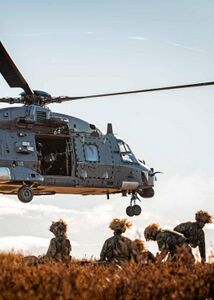
The Arcerion Army has a mixture of equipment dating from legacy procurements in the late 20th century to newer procurements and additions to the arsenals of its armed forces. In general, the regular army units on higher readiness will receive newer equipment than their reserve counterparts. With recent initiatives, the Army has focused on three main facets of their vehicle fleets, their 'A' fleet, or 'Armoured,' is the actual combat and fighting vehicles that represent the maneouvre strength in both the infantry battalions and their supporting or enabling units. An example of this would be the legacy LAV-91 fleet.
The Light Armoured Vehicle-1991 was the Arcer Army's effort to replace its tracked vehicle fleet with a newer and more expeditionary-friendly deployable capability. The LAV-91 serves as the cornerstone of the Arcer Army, with every infantry battalion, save for the airborne or light infantry, having them as their main combat vehicle. With a crew of three, and the capability to dismount up to eight personnel, the LAV-91 project was the most ambitious for its time as yet undertaken by the Army since the 2GW. Other vehicles in the 'A' fleet include main battle tanks, combat engineering vehicles, as well as other heavier tracked assets. Important to note, is that the LAV-91 is set to be life cycled and replaced by an entirely new motorised concept that will enhance the lethality of the Arcer Army for years to come.
The 'B' fleet is comprised of vehicles that perform supporting or non-combat functions. This includes but is not limited to the entire truck fleet (6-tonne, 4-tonne, etc.), light jeeps and wheeled staff vehicles, all-terrain vehicles and off-road light vehicles, and assorted construction equipment. Within the truck fleet, this importantly includes fuel bowsers and maintenance vehicles such as wreckers or tow vehicles. Critical pieces of Arcer mobility operations, these vehicles represent the true nervous system and life support system of the Army. The Army's infantry equipment was standardized in the early 2000s, and focused on adopting a rifle system and standalone grenade launcher system to complement the existing squad and platoon weapons. The traditional Arcer love for individual marksmanship (a cultural landmark) came to a clash during the 1GW and the rise of the era of modern machineguns, and as such since the GPMG has been a staple in Arcer rifle platoons. Additionally, Arcer emphasis on infantry formations having as much decentralized enabling functions as meant there is a range of anti-armour weapons. Under the umbrella of 'AAW', the family has expanded to include the SRAAW (66mm HEAT), the MRAAW (81mm HEAT), and the NGAAW (150mm, smart anti-tank projectile). This is complemented by an integrated radio and fires sytsem provided by the Wireless and Antenna Division of Arcerion Armaments Industries (AAI), which produces the radios and integrated systems engineering solutions for most of Arcerion's armed services.
The Army's artillery systems focus on a scaled approach, with light and medium mortars (60mm & 81mm) being held by the infantry, and larger systems such as 120mm mortars, 105mm & 155mm howitzers residing with the Regiment of Arcer Horse Artillery. Additionally, the RAHA has rocket artillery in smaller, limited numbers, but is looking to increase these capabilities as part of an emphasis and shift to deep-strike capabilities.
Training
All Arcer soldiers go through an initial branch-agnostic basic training for 10-weeks. This takes place at the Craigfearn Garrison, at the Arcerion Armed Forces Leadership and Recruit School (AAFLRS). This initial 10 weeks is focused on giving recruits the skills they need to function as a member of a team, understand how to wear a uniform and orient themselves to function properly in a military setting. After these 10 weeks, recruits are sent either to their respective Army, Air Force, or Naval schools for an additional 4-week integration for service-specific indoctrination. For the Army, this enhances the extremely basic field skills recruits learned in Basic Training. These 4 weeks are known as "Advanced Army Training," and cover a range of activities from handling of additional weapons systems to section- and platoon-level operations. During this period initial assessments for leadership capability are assessed and developed and added to the soldier's personnel file. After this period, candidates are then sent to their individual battle schools for the combat arms, or technical schools for supporting or specialist trades. Examples for this include prestigious institutions such as the Royal Arcerion School of Infantry (RASI) or the Royal Arcerion Signal Corps School (RASCS). In the infantry context, soldiers will arrive at the Royal Arcerion School of Infantry for a 10-week indoctrination into infantry culture, Regimental history, and gradually progress from fighting as a member of a section all the way up to company live-fire events.
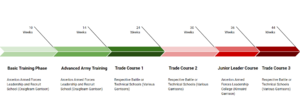
Soldiers in their Trade Course 1 learn the basic fundamentals that qualify them in their respective field, be that infantry, signals, combat engineering, basic medicine, or other required roles within the Army. After this, they are posted to their first garrison unit or Regiment for their initial developing period. After some time has elapsed, they are sent on their Trade Course 2, where they learn advanced skills that assist with their ability to become a subject matter expert in their field. Whereas Trade Course 1 only qualifies a member to Private, the Trade Course 2 standard allows them to be promoted to Lance Corporal. To again use the infantry context, whereas Trade Course 1 qualifies a soldier to be a rifleman or light machinegunner in an infantry section, Trade Course 2 qualifies them to act as a Section 2IC, or a weapons detachment commander, giving them greater access to educational materials and teaching on advanced weapons systems they may not ordinarily encounter such as vehicle-mounted ATGMs or some MANPADs, in addition to other application for machineguns.
By this point, Arcer soldiers are ready to begin their leadership training, and based off their quarterly and yearly assessments, the soldiers are loaded onto their Junior Leadership Course, a 6-week program designed to give them the ability to teach, instruct, lead, and manage a section (8 members). Graduating from this difficult course qualifies them to be Corporals. The course is considered difficult as it has an attrition threshold to ensure that only physically and mentally fit members pass. This is usually followed by most trades with Trade Course 3, or the advanced skills training. This training not only builds on previous training, but gives them the ability to now be supervisors over multiple specialties within their trade. To use the Armoured crewman example, a TC1-qualified Trooper could be a driver or loader, a TC2-qualified Lance Corporal is usually a gunner or in extremis a Vehicle Commander, but Trade Course 3 now gives a crewman his Vehicle Commander's qualification, as well as the ability to qualify multi-platform (ie. LAV-91 and main battle tanks).

After this, soldiers are assessed for further ranks using the NCO Rating and Evaluation system, which nominates candidates for academic education concurrent to their military learning. To be promoted to Sergeant requires Trade Course 4 and the Intermediate Leadership Course 1, and for their Warrant Officer promotion they require their Intermediate Leadership Course 2.
The Arcer military education system year-by-year succeeds on force generating thousands of newly qualified soldiers and leaders to sustain the Army's needs for an educated, physically fit, and well-led force to defend Arcer interests.

Major Installations
Kinnaird Garrison
The Kinnaird Garrison, located in Kinnaird, Arcerion is one of the most prestigious military bases in Arcerion. It houses a variety of combat and support units, notably the Kinnaird Foot Grenadiers, with three infantry battalions. The Kinnaird Garrison also hosts the Arcerion Army Command and Staff College, as well as two other key institutions, the Arcerion Doctrine and Training Centre, and the Royal Arcerion Institute for War Studies.
Dalfearn Garrison
Craigfearn Garrison
Fort Ellis (Kurst)
Fort Ellis, located in Kurst, is the oldest historical military installation in Arcerion. Beginning as an artillery revettment with earthen berms, over several decades it was gradualyl expanded into a modern stone-and-earthen star fort, with mounted cannons to engage ships at sea and a permanent garrison of Carnish and Arcer regular soldiers in its barracks. It is also the traditional founding location of the Arcer Army, and as such has a significant historical value for the Army's heritage. Today, it serves as an entirely staff and headquarters role, with modern buildings outside the fort serving as the headquarters of 2nd Division (Moorden), at the Red Lion Barracks. It also has a contingent from two of Arcerion's oldest infantry regiments, the Royal Arcerion Regiment and Royal Moorden Regiment, both of which have ceremonial companies that support the Fort Ellis Museum and National Historical Site. Fort Ellis also is a designated Heritage Site by the Arcer National Archives.
Arcerion Maneuver Training Centre (Presdale Garrison)
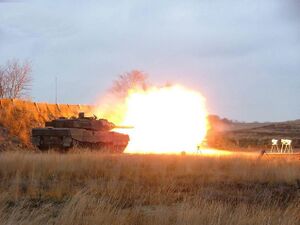
The Arcerion Maneuver Training Centre is located at the Presdale Garrison in Northern Arcerion. It is almost 5,000km², and is the largest live-fire and air-ground training centre in Crona. AMTC provides the ability for Arcer units to train live with multiple battlegroups and enabling assets such as rocket artillery, aerial strikes, and large-scale maneuver warfare. It also is co-located with the Royal Arcerion Armoured School (RAAS), which trains armoured crewmen for the Arcer Army. AMTC was created after the 1GW as part of an initiative to foster a small armoured corps in Arcerion. Over the successive decades and wars, it has continued to grow in size both in terms of the garrison proper, but also the training area, which now covers a vast swathe in the northern portions of Northlea governorate. AMTC annually hosts multiple large-scale brigade-level exercises, and every month hosts a variety of training events, from Trade Courses for the combat arms, to live-fire ranges, or force-on-force exercises as part of annual readiness training. As part of regular Cronan Security and Trade Union verification, AMTC now has the ability to host foreign brigades belonging to Alstin and Paulastra for extended periods of training, including the Arco-Paul Brigade.